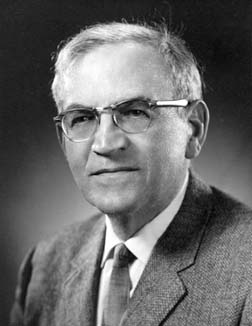
Isaac Jacob Schoenberg
 المؤلف:
R Askey and C de Boor
المؤلف:
R Askey and C de Boor
 المصدر:
In memoriam : I J Schoenberg (1903-1990)
المصدر:
In memoriam : I J Schoenberg (1903-1990)
 الجزء والصفحة:
...
الجزء والصفحة:
...
 18-9-2017
18-9-2017
 970
970
Born: 21 April 1903 in Galați, Romania
Died: 21 February 1990

Isaac Schoenberg was known as Iso to his friends. His father was a medical doctor but he was fascinated by mathematical puzzles, an interest he soon gave to Isaac. Schoenberg studied at the University of Jassy (Iasi, Moldavia) and received his M.A. in 1922. During 1922-25 he studied at Berlin, where he came under Schur's influence, and at Göttingen. During this time he was engaged in research on a topic in analytic number theory suggested by Schur. He presented his thesis to the University of Jassy and was awarded his Ph.D. in 1926.
At Göttingen Schoenberg met Edmund Landau and it was Landau who arranged a visit for Schoenberg to the Hebrew University of Jerusalem which he made in 1928. It was during this visit that [1]:-
... Schoenberg became interested in estimating the number of real zeros of a polynomial and so began his very influential work on Total Positivity and Variation diminishing linear transformations...
Landau, however, proved important in other ways in Schoenberg's life. In 1930, after his return from Jerusalem, Schoenberg married Landau's daughter Charlotte in Berlin. This was not his only mathematical connection by marriage since his sister married Hans Rademacher.
In 1930 Schoenberg was awarded a Rockefeller fellowship which enabled him to go to the United States. There he was a postdoctoral worker at Chicago, where he collaborated with Bliss, and then at Harvard. In 1933 he became a member of the Institute for Advanced Study at Princeton and he remained there until 1935. At Princeton he began working on distance geometry, namely [1]:-
...the isometric imbedding of metric spaces into Hilbert space and positive definite functions.
After Princeton, Schoenberg held posts at Swarthmore College and Colby College. Then, in 1941, he was appointed to the faculty at the University of Pennsylvania. During the years 1943-45 he was released from the University of Pennsylvania for war work as a mathematician at the Army's Ballistic Research Laboratory in Aberdeen, Maryland (the Aberdeen Proving Ground). It was during this war work that he initiated the work for which he is most famous, the theory of splines. Karlin writes in [4]:-
... Schoenberg is noted worldwide for his realisation of the importance of spline functions for general mathematical analysis and in approximation theory, their key relevance in numerical procedures for solving differential equations with initial and/or boundary conditions, and their role in the solution of a whole host of variational problems. The fundamental papers by Schoenberg [two papers in 1946] form a monument in the history of the subject as well as its inauguration.
The authors of [1] state:-
For the next 15 years, Schoenberg had splines all to himself. This changed around 1960, when computers became more widespread and splines first assumed their role as the premier tool for data fitting and computer-aided geometric design. Schoenberg's more than 40 papers on splines after 1960gave much impetus to the rapid development of the field.
Schoenberg made further outstanding contributions in a series of papers between 1950 and 1959 on the theory of Pólya frequency functions. His work here extended that begun by Pólya, Laguerre and Schur on approximating functions by polynomials with only real zeros. This work led Schoenberg to discover remarkable properties of polynomials all of whose zeros are negative and real.
In 1966 Schoenberg moved from the University of Pennsylvania to the University of Wisconsin where he became a member of the Mathematics Research Center. He remained at Wisconsin-Madison until he retired in 1973. However, he continued to produce important works after he retired and of his 174 papers and books, over 50 appeared after his retirement. During his time at Wisconsin, Schoenberg introduced another concept of major importance, namely cardinal splines. He investigated their wide applications in approximation theory in a series of three papers between 1969 and 1973.
Schoenberg published joint papers with a number of mathematicians including his brother-in-law Rademacher. He also collaborated with Besicovitch, Erdos, Curry, von Neumann and Szego. Although he never produced a joint publication with his father-in-law Landau, he did spend a great deal of his time working on problems that Landau had considered.
In [4], written at the time he retired in 1973, his interests were described:-
Schoenberg is a man of broad culture, fluent in several languages, addicted to art, music and world literature, sensitive, gracious and giving in all ways. [He] frequently builds physical models related to his mathematical enquiries. ... The working desk at his home where he engages in research is actually a draftsman's bench complete with T-square, etc. and a tall stool. Mobiles, artistic works, models of ruled surfaces, icosahedrons and other objects are strewn throughout the room. English, French and German novels, numerous paintings and artefacts are scattered on all the nearby easy chairs. He buys and collects books of all vintages with passion. Historical mathematical discourses especially fascinate him and his articles frequently reflect this interest.
Articles:
- R Askey and C de Boor, In memoriam : I J Schoenberg (1903-1990), J. Approx. Theory 63 (1) (1990), 1-2.
- C Corduneanu, Isaac J Schoenberg, Libertas Math. 8 (1988), 3-10.
- Doctoral students of I J Schoenberg, J. Approximation Theory 8 (1973), xv.
- S Karlin, To I J Schoenberg and his mathematics, J. Approximation Theory 8 (1973), vi-ix.
- List of publications of I J Schoenberg, J. Approximation Theory 8 (1973), x-xiv.
 الاكثر قراءة في 1900to1904
الاكثر قراءة في 1900to1904
 اخر الاخبار
اخر الاخبار
اخبار العتبة العباسية المقدسة


